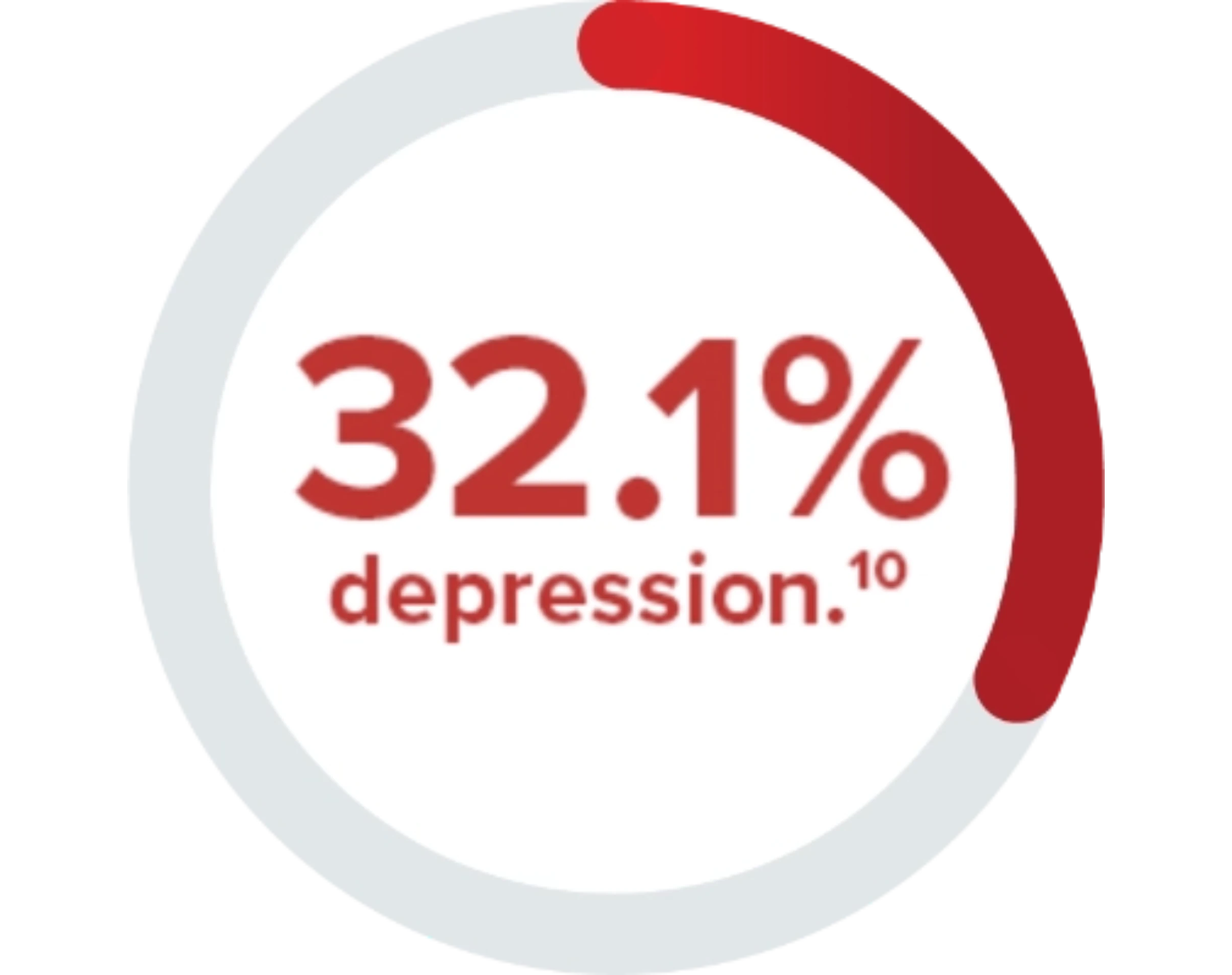- Article
- Source: Campus Sanofi
- May 20, 2025
Psychological & Economical impact

cGVHD impacts patients’ psychological health
Approximately one-third of patients with moderate to severe cGVHD have clinically significant psychological distress, including depression or anxiety.10
In a prospective observational study evaluating 53 patients with moderate to severe cGVHD, the rates of clinically significant depression and anxiety symptoms were


Greater cGVHD symptom burden was associated with an increased rate of depression.10
In a multicenter, prospective, observational cohort study of 298 patients, when comparing mean SF-36 scores with those of other chronic health conditions, patients with severe cGVHD had MCS comparable with depression.8
cGVHD poses multiple economic challenges for patients
Patients who undergo an allogeneic HCT face financial hardship, which may be further amplified by a diagnosis of cGVHD.
A multicenter, prospective, observational cohort study evaluated 298 patients wiA study that supplemented data from the multicenter, prospective, observational Chronic GVHD Consortium Response Measures Validation Study found that11
.png)
24%
reported having difficulty paying medical bills
.png)
28%
did not have enough money at the end of the month
.png)
49%
reduced spending on utilities and other expenses
%20(1).png)
31%
used retirement savings
.png)
16%
borrowed money or sold assets
Factors that contributed to this financial burden included multiple treatments, inability to return to work, frequent physician visits and losing/changing insurance.11
| Sixty-six percent of patients with cGVHD face a financial challenge after transplant, regardless of insured status.11 Twenty-five percent of patients will lose 20 years of earnings because of permanent disability.12 Overall, patients with cGVHD are significantly less likely to return to the workforce, even 2 to 3 years after transplant, compared with those without cGVHD.13 |
Even in patients receiving treatment, cGVHD has a considerable impact on QOL, as well as psychological and financial well-being.
.png)
cGVHD, chronic graft-versus-host disease; FACT-BMT, Functional Assessment of Cancer Therapy-Bone Marrow Transplant; HCT, hematopoietic cell transplant; MCS, mental component score(s); PCS, physical component score(s); QOL, quality of life; SF-36, 36-Item Short-Form Survey.
-
Fiuza-Luces C, Simpson RJ, Ramírez M, Lucia A, Berger NA. Physical function and quality of life in patients with chronic GvHD: a summary of preclinical and clinical studies and a call for exercise intervention trials in patients. Bone Marrow Transplant. 2016;51(1):13-26. doi:10.1038/bmt.2015.195
-
Martires KJ, Baird K, Steinberg SM, et al. Sclerotic-type chronic GVHD of the skin: clinical risk factors, laboratory markers, and burden of disease. Blood. 2011;118(15):4250-4257. doi:10.1182/blood-2011-04-350249
-
Henden AS, Hill GR. Cytokines in graft-versus-host disease. J Immunol. 2015;194(10):4606-4612. doi:10.4049/jimmunol.1500117
-
Arora M, Cutler CS, Jagasia MH, et al. Late acute and chronic graft-versus-host disease after allogeneic hematopoietic cell transplantation. Biol Blood Marrow Transplant. 2016;22(3):449-455. doi:10.1016/j.bbmt.2015.10.018
-
Inagaki J, Moritake H, Nishikawa T, et al. Long-term morbidity and mortality in children with chronic graft-versus-host disease classified by National Institutes of Health Consensus Criteria after allogeneic hematopoietic stem cell transplantation. Biol Blood Marrow Transplant. 2015;21(11):1973-1980. doi:10.1016/j.bbmt.2015.07.025
-
Au BKC, Au MA, Chien JW. Bronchiolitis obliterans syndrome epidemiology after allogeneic hematopoietic cell transplantation. Biol Blood Marrow Transplant. 2011;17(7):1072-1078. doi:10.1016/j.bbmt.2010.11.018
-
Lee SJ, Onstad L, Chow EJ, et al. Patient-reported outcomes and health status associated with chronic graft-versus-host disease. Haematologica. 2018;103(9):1535-1541. doi:10.3324/haematol.2018.192930
-
Pidala J, Kurland B, Chai X, et al. Patient-reported quality of life is associated with severity of chronic graft-versus-host disease as measured by NIH criteria: report on baseline data from the Chronic GVHD Consortium. Blood. 2011;117(17):4651-4657. doi:10.1182/blood-2010-11-319509
-
Baird K, Steinberg SM, Grkovic L, et al. National Institutes of Health chronic graft-versus-host disease staging in severely affected patients: organ and global scoring correlate with established indicators of disease severity and prognosis. Biol Blood Marrow Transplant. 2013;19(4):632-639. doi:10.1016/j.bbmt.2013.01.013
-
Waldman L, Traeger L, Fishman S, et al. Psychological distress in patients with moderate to severe chronic graft-versus-host disease (cGVHD). J Clin Oncol. 2010;36(suppl 15). doi:10.1200/JCO.2018.36.15_suppl.e22137
-
Khera N, Hamilton BK, Pidala JA, et al. Employment, insurance, and financial experiences of patients with chronic graft-versus-host disease in North America. Biol Blood Marrow Transplant. 2019;25(3):599-605. doi:10.1016/j.bbmt.2018.09.040
-
Jones CA, Fernandez LP, Weimersheimer P, et al. Estimating the burden of cost in chronic graft-versus-host disease: a human capital approach. JHEOR. 2016;4(2):113-118. doi:10.36469/9814
-
Wong FL, Francisco L, Togawa K, et al. Long-term recovery after hematopoietic cell transplantation: predictors of quality-of-life concerns. Blood. 2010;115(12):2508-2519. doi:10.1182/blood-2009-06-225631
MAT-SA-2300860/v2/March2024